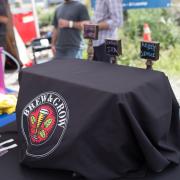In the past few months I have been making some terrible tasting beer. I brew all-grain. The beers I have brewed that taste terrible are a Honey brown ale, Belgian Tripel, and English Barley Wine. They all have a distinct rubbing alchol, plasticy, weird banana taste. My most recent brew is the English Barley Wine. I just transferred this to the secondary fermentation after approx. 2 weeks in the primary. When first smelling this beer I knew it was going to taste terrible. There was no signs of any maltiness in this beer. It actually smelled alot like the bad tripel I brewed. I fermented this Barley Wine at about 68 degrees with little variation on temp. I get a bad rubbing alcohol smell and taste and there are other harsh flavors that I just can not describe. So I have been thinking about my brewing process and whether I have done anything different. One thing I am doing different now that I brew all-grain is I use my home's softened well water. When I did extract I always used bottled water and always made beer without any noticeable off flavors. Thats not to say i have never brewed a good batch of beer brewing all grain with softened water. But the beers that did turn out good either used alot of specialty grains or were hoppy which probably did a good job of hiding these off flavors.
My question to everyone is, could the softened water I am using be adding off flavors to the beer I brew? Does anyone else brew with well water? Any help will be appreciated!
Also, for anybody that is going to the Style sampling event on Oct 30th, I will be bringing my tripel and my english barley wine both which have these off flavors. So you will get to taste my bad beer!









Do you drink the softened well water on a daily basis? Does it have any weird flavors when you drink it out of the faucet?
I have been drinking this water my entire life. So if it does have any weird flavors, I am used to them by now. I will say it does taste a little different then city water but not necessarily worse.
Kevin Saberniak
Gotcha.
A good rule of thumb for water for brewing, without getting too specific into the profile/chemistry, is you want to use water that you think tastes best.
Have you ever done a side-by-side with your well water and bottled spring water? Might be something to try out, just to see the difference.
I think the evidence is pretty clear that your well water is producing those off-flavors. I'd probably go back to using bottled spring water, or even better, start looking into building the water from scratch with distilled or Reverse Osmosis water.
What happens if the well water isn't softened? What if you took it from the garden hose spigot? Is there a different flavor there? If so I'd get my brewing water needs from the spigot. You might also consider setting up a little portable water filter at the garden hose with an inline charcoal filter. I take all my water from the outdoor spigot and filter it before boiling. You should also PH test your water and see where thats at. These things never came up before in your bottled water days because that water is neutral (but expensive at 2.5/gal a pop).
--james
Its almost certainly the softened water. Either that or you have a serious infection in your system. But softened water is a paticular no, no for homebrew. What you described is classic phenols.
Phenolic
This is an aroma and taste often compared to Band-aids (tm), medicine chest or disinfectant. Chlorophenols are particularly offensive members of this family with bleach-like flavors in addition to the ones listed above. High levels of phenols are generally produced by bacteria or wild yeast, both of which indicate a sanitation problem. Phenols may also be extracted from grain husks by overcrushing, oversparging or sparging with hot or alkaline water. Chlorinated water or sanitizer residue are possible sources of chlorophenols.
The part about sparging with alkaline water is probably one the causes, softened water has a higher ph than tap water because it strips out some ions that add acidity to water. The way a water softener works is it strips out the calcium ion and the magnesium ions and replaces them with sodium ions. The Ca and Mg are essential for yeast heath so you may be getting some other problematic flavors from stressed yeast too. The sodium ions are almost never good in pale beers but do help out in dark beers. The concentrations of sodium you are getting could be much higher than acceptable even in dark beers though.
So, to fix the problem you are going to have to play around with your water chemistry. Four ways to do it:
1. Get your water tested, adjust your water using brewing salts and acids to get the ph correct and the mineral levels correct, particularly the Ca and Mg. However sodium will always be an issue and your pale beers will not be your best.
2. Put a substantial filter on the un softend water source. Get this tested. Adjust with brewing salts to get the best water for the style. Your base water should be great for making stouts, but should work for most other styles.
3. Buy RO or purified water. If its purified get the water report. Build the water up using brewing salts to create profiles that match the style being brewed. Both these types of water are lacking in Ca and Mg too so they have to be added. RO water with a little mineral adjustment is great for pale beers.
4. Brew at the brewhouse, we filter our city water. Mineral additions are good and will make the beer better but not necessary.
You can use options two and three interchangeably depending on the style (light or dork), option 1 probably isn't the best way to go.
In conclusion, you would be well served by learning water chemistry. There is a four part episode of brew strong that is particularly helpful, also John Palmer has a nice youtube video going over the basics.
http://thebrewingnetwork.com/shows/497
http://www.youtube.com/watch?v=zJj__jEkFUE